Multiples and Fractions of Fractions: 3.25
Supporting materials
- Related Progression Points
- Developmental Overview of Proportional Reasoning and Multiplicative Thinking (PDF - 41Kb)
- Developmental Overview of Methods of Calculation (PDF - 38Kb)
Indicator of Progress
Success depends on students using models of fractions to explain the meanings of an increasing range of fraction operations. They can use a model to find the results of an increasing (but still carefully selected) range of fraction calculations. They can increasingly link observations about the model to fraction number sentences.
For example, they can see that 3 lots of 2/3 of an apple is the same quantity as 2 apples and that a half of a third of a pizza is one sixth of the pizza.
NOTE: At this stage, they make some progress to linking these intuitive understandings with the symbolic forms (e.g. the fraction number sentences 2 × 1/3 = 2/3, 1/6 + 1/3 = 1/2 ). This is by reference to the meaning of the statements, not to the general algorithms, which are not yet taught.
Illustration 1: Explaining fraction operations with models
This indicator of progress extends the previous use of models for fractions in three ways. From earlier levels, students:
- can explain the meanings of some fraction operations using a model (e.g. a third plus a third, half of a third using parts of an apple as a model).
- can use a model to solve some calculations. For example, they can illustrate 2/5 + 4 /5 using an area model and give the result as 1 1/5 .
- can link observations about a model to a number sentence. For example, they can describe the observation that 4 eights are a half as 4 × (1/8) = 1/2. At this level, these abilities are extended to include multiples and fractions of fractions. (e.g. 4 × (1/8) = 1/2, 1/2 divided by 1/3 = 1/6, 1/3 of 1/2 = 1/6).
Illustration 2: Describing observations with a model by number sentences
They can also link observations about a model to a number sentence. For example, they can describe the observation that 4 eighths are a half as 4 × 1/8 = 1/2.
Conversely, given the number sentence, they can describe a model that might illustrate it. For example: "I take a circle to represent the whole, divide it into eighths, and take four of them. This is half of the circle ."
Teaching Strategies
The teaching strategies here are illustrated with just one model, the fraction wall. This is a linear model, where the size of a fraction is represented by the length of a strip of paper. A variety of models can be used for any one topic during a student's schooling, but concentrated use of one model has advantages. The aim of learning with a model is to give a student a tool to think with; something that they can draw upon to interpret symbolic work. So models should be carefully chosen and used thoroughly and consistently for some time.
The activities suggested provide opportunities for open ended discovery by students and development of language, as well as diagnostic information about students' stages.
Activity 1: Making a fraction wall is a good introductory activity with diagnostic potential.
Activity 2 and Activity 3 consolidate and extend these ideas.
Activity 1: Making a fraction wall
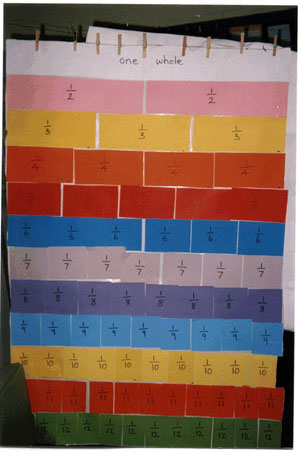
Show students a completed fraction wall on the noticeboard or OHP and ask them to make their own by folding strips of paper that you provide. Each strip (about 20 cm) has the length of one unit. They should mark the fold lines and then write the length of the fraction piece on the paper as they create it. Check their work before they assemble them into their own fraction wall.
This activity provides a chance to observe several stages of learning.
Observation 1. Folding but not bisecting
Given 4 strips of paper, some students may:
- write 1 on the first
- fold the second strip in halves, label each of the two portions as 1 /2
- fold the third strip in half twice, label each of the four portions as 1 /4 (or maybe 1/3 ?)
- fold the fourth strip in half three times, label each of the eight portions as 1/8
Some children may not realise that most fractions (such as 1/3 and 1/5) cannot be made by repeatedly folding in halves (bisecting). They will need help to break this mental set. You might suggest a useful technique: folding the paper into an S shape and then adjusting as required. This is even easier to do with a length of string, which can be threaded between students’ fingers.
Work with students having difficulty to encourage them to predict the effects of folding eg get a student to predict the effect of two folds before they unfold the strip to check.
Watch also for students who confuse the number of folds and the length of the pieces. For example, do they appreciate that there are only 7 folds on the fraction strip showing 1/8 s?
Observation 2. Observe whether students build up folding from earlier stages
Ask students how they made sixths, for example they might 'halve thirds' or 'third halves'. This is an important observation, that relates to equivalent fractions and forms the basis of multiplication and division of fractions.
Observation 3. Observe what links students see and use
While it is difficult to form near-perfect pieces, aiming for a very good fraction wall is a valuable activity as students:
- focus on creating equal-sized pieces
- appreciate that 3 sixths is the same as 4 eighths (equivalent fractions) etc.
- realise that 1/7 is a fraction (not on many commercial models) etc.
- realise that 1/7 will be a bit bigger than 1/8 and a bit smaller than 1/6 etc.
Note: The real fraction wall is in your head
Even if you get a very well constructed fraction wall, it will only give a guide to fraction equivalences. The convincing explanation is always in your head. For example, two quarters might LOOK like a half on a fraction wall, but we know that they really are exactly equal because of how they are made.
Activity 2: Consolidating ideas of fractions with a fraction wall
There are many opportunities for exploring fraction ideas using a fraction wall. These can be demonstrated on the fraction wall. Small sections which highlight a particular feature can be remade and pasted into books, and relationships can be expressed symbolically as desired. The following gives an outline of possibilities.
(a) How big are fractions?
The '1' is shown by the length of the strip. The size of a unit fraction is represented on the fraction wall by the sub-divided length of the strip. Notice the relative lengths for unit fractions (higher denominator - smaller fraction size), look on the wall for 'exact matches' (such as 3 sixths and 1 half) or 'near matches' (e.g. 3 fifths is about the same as 5 eighths) etc. Use a ruler to check vertical alignments.
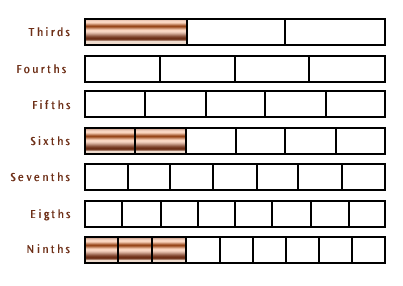 |
(b) Multiples of fractions (and the ever-present equivalent fractions)
Notice families of equivalent fractions on the fraction wall and record them symbolically. Get students to explain why they work. Extend beyond the fraction wall.
e.g. 4/12 = 3/9 = 2/6 = 1/3
This means that 4 strips of length 1/12 are as long as 3 strips of length 1/9 etc.
Observe the multiplication number patterns.
 |
(c) Fractions of fractions (and the ever-present equivalent fractions, of course!)
Ask students to record observations about fractions of fractions.
For example, a half of a third is a sixth. This means that a sixth on the strip is exactly half as long as a third on the strip. Advanced students will be able to record these results symbolically, but keep the emphasis here on calculating from the meaning, not using an algorithm.
|
1/2 of 1/3 = 1/6
|
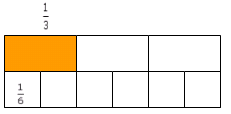 |
Don't forget observations using fractions greater than one e.g., the length of 'one and a half' thirds is the same as the length of a half.
(d) Addition and subtraction
Students can make interesting observations about adding and subtracting, checking these calculations with their own and their friends' fraction strips. As with all concrete models, the fraction wall only shows that two quantities are likely to be equal. You have to think abstractly, drawing on mathematical understanding, to be sure.
| Examples | |
|
1/2 + 1/8 = 5/8
|
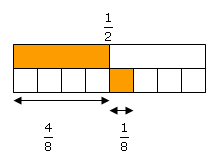 |
|
1/2 − 1/3 = 1/6
|
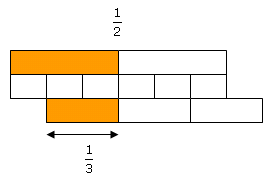 |
Activity 3: Fraction Wall Game
Each student has a fraction wall with divisions marked, but not shaded.
Each group of students needs two 10-sided dice.
Each student takes it in turn to roll 2 dice. Form a proper fraction (less than or equal to 1) with the numbers thrown. For example if 3 and 5 are showing, form the fraction 3/5 and not 5/3. The student can colour in the corresponding length on the fraction wall. The winner is the first person with three completely shaded fraction wall strips (eg the eighths, the quarters and the fifths).
First version: Allow students to shade only the fraction shown. So that if the fraction is 3/5, only a section of the fifths strip can be shaded.
Second version: Allow students to shade any fraction equivalent to the one shown. So that if the fraction is 3/5, 6 of the parts of the tenths strip can be shaded.
Third version: Allow students to shade the fraction shown in total across strips. So that if the fraction is 3/5, 2 fifths can be shaded, along with 2 tenths.
References
Some material is from Marston, K. & Stacey, K. (Eds.) (2003). Foundations for Teaching Arithmetic. Version 2. Faculty of Education, University of Melbourne . http://extranet.edfac.unimelb.edu.au/DSME/arithmetic
Kate Hughes kindly gave us permission to use the picture of the fraction wall.
Further Resources
The following resource contains sections that may be useful when designing learning experiences:
Digilearn object *
Exploring fractions – students use partially filled measuring cups to explore fractions: improper, mixed and equivalent fractions. For example, select six cups which are one-quarter full to balance one and a half cups. Or achieve an equivalent result by selecting three cups, which are half full.
(https://www.eduweb.vic.gov.au/dlr/_layouts/dlr/Details.aspx?ID=5200)
* Note that Digilearn is a secure site; SMART::tests login required.
